
Douglas MacArthur was an American general who served as a top commander during World War II and the Korean War, achieving the rank of General of the Army. He served with distinction in World War I; as chief of staff of the United States Army from 1930 to 1935; as Supreme Commander, Southwest Pacific Area, from 1942 to 1945 during WWII; as Supreme Commander for the Allied Powers overseeing the occupation of Japan from 1945 to 1951; and as head of the United Nations Command in the Korean War from 1950 to 1951. MacArthur was nominated for the Medal of Honor three times, and was awarded it for his WWII service in the Philippines. He is one of only five men to rise to the rank of General of the Army, and the only one to hold the rank of Field Marshal in the Philippine Army.

Jonathan Mayhew Wainwright IV was an American army general and the Commander of Allied forces in the Philippines at the time Japan surrendered to the United States, during World War II.

The Bataan Death March was the forcible transfer by the Imperial Japanese Army of around 72,000 to 78,000 American and Filipino prisoners of war (POW) from the municipalities of Bagac and Mariveles on the Bataan Peninsula to Camp O'Donnell via San Fernando.

The Japanese Instrument of Surrender was the written agreement that formalized the surrender of the Empire of Japan, marking the end of hostilities in World War II. It was signed by representatives from the Empire of Japan and from the Allied nations: the United States of America, the Republic of China, the United Kingdom of Great Britain and Northern Ireland, the Union of Soviet Socialist Republics, the Commonwealth of Australia, the Dominion of Canada, the Provisional Government of the French Republic, the Kingdom of the Netherlands, and the Dominion of New Zealand. The signing took place on the deck of USS Missouri in Tokyo Bay on 2 September 1945.
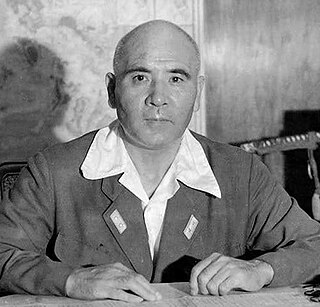
Masaharu Homma was a lieutenant general in the Imperial Japanese Army during World War II. Homma commanded the Japanese 14th Army, which invaded the Philippines and perpetrated the Bataan Death March. After the war, Homma was convicted of war crimes relating to the actions of troops under his direct command and executed by firing squad on April 3, 1946.

Tomoyuki Yamashita was a Japanese convicted war criminal and general in the Imperial Japanese Army during World War II. Yamashita led Japanese forces during the invasion of Malaya and Battle of Singapore. His conquest of Malaya and Singapore in 70 days earned him the sobriquet "The Tiger of Malaya" and led to the British Prime Minister Winston Churchill calling the ignominious fall of Singapore to Japan the "worst disaster" and "largest capitulation" in British military history. He was assigned to defend the Philippines from the advancing Allies later in the war. Although he was unable to prevent the superior Allied forces from advancing, despite dwindling supplies and Allied guerrilla action, he was able to hold on to part of Luzon until after the formal Surrender of Japan in August 1945.

Arthur MacArthur Jr. was a lieutenant general of the United States Army. He became the military Governor-General of the American-occupied Philippines in 1900; his term ended a year later due to clashes with the civilian governor, future-U.S. President William Howard Taft.

Major General Courtney Whitney was a lawyer and United States Army commander during World War II who later served as a senior official during the American occupation of Japan (1945–1951). He played a major role in the liberalization of Japanese government, society, and economy during the occupation.
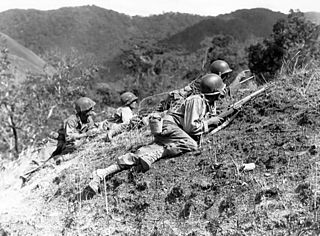
The Battle of Luzon was a land battle of the Pacific Theater of Operations of World War II by the Allied forces of the U.S., its colony the Philippines, Mexico, and allies against forces of the Empire of Japan. The battle resulted in a U.S. and Filipino victory. The Allies had taken control of all strategically and economically important locations of Luzon by March 1945, although pockets of Japanese resistance held out in the mountains until the unconditional surrender of Japan. While not the highest in U.S. casualties, it is the highest net casualty battle U.S. forces fought in World War II, with 192,000 to 217,000 Japanese combatants dead, 8,000 American combatants killed, and over 150,000 Filipinos, overwhelmingly civilians who were murdered by Japanese forces, mainly during the Manila massacre of February 1945.

The Battle of Manila was a major battle of the Philippine campaign of 1944–45, during the Second World War. It was fought by forces from both the United States and the Philippines against Japanese troops in Manila, the capital city of the Philippines. The month-long battle, which resulted in the death of at least 100,000 civilians and the complete devastation of the city, was the scene of the worst urban fighting fought by American forces in the Pacific theater. During the battle, Japanese forces committed mass murder against Filipino civilians, while American firepower killed many people. The resistance of the Japanese and American artillery also destroyed much of Manila's architectural and cultural heritage dating back to the city's founding. Often referred to as "the Stalingrad of Asia", the battle is widely considered to be one of the most intense and worst urban battles ever fought, with it being the single largest urban battle ever fought by American forces.

The Philippines campaign, Battle of the Philippines, Second Philippines campaign, or the Liberation of the Philippines, codenamed Operation Musketeer I, II, and III, was the American, Filipino, Australian, and Mexican campaign to defeat and expel the Imperial Japanese forces occupying the Philippines during World War II.

The South West Pacific theatre, during World War II, was a major theatre of the war between the Allies and the Axis. It included the Philippines, the Dutch East Indies, Borneo, Australia and its mandate Territory of New Guinea and the western part of the Solomon Islands. This area was defined by the Allied powers' South West Pacific Area (SWPA) command.
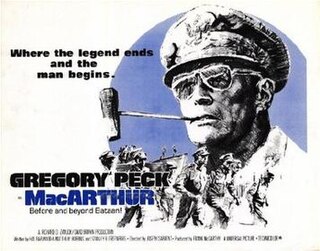
MacArthur is a 1977 American biographical war film directed by Joseph Sargent and starring Gregory Peck in the eponymous role as American General of the Army Douglas MacArthur.
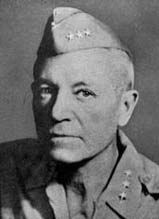
Lieutenant General Oscar Woolverton Griswold was a United States Army officer who served in the first half of the 20th century. He is best known for his command of the XIV Corps in the South Pacific Area and South West Pacific Area during World War II.
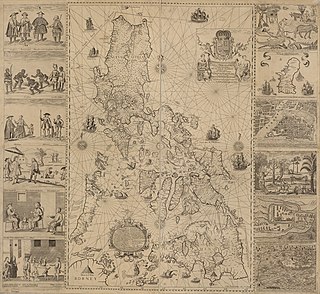
The Japanese occupation of the Philippines occurred between 1942 and 1945, when the Japanese Empire occupied the Commonwealth of the Philippines during World War II.

Back to Bataan is a 1945 American black-and-white World War II war film drama from RKO Radio Pictures, produced by Robert Fellows, directed by Edward Dmytryk, that stars John Wayne and Anthony Quinn. The film depicts events that took place after the Battle of Bataan (1941–42) on the island of Luzon in the Philippines. The working title of the film was The Invisible Army.

This is the service summary of Douglas MacArthur, a General in the United States Army, who began his career in 1903 as a second lieutenant and served in three major military conflicts, going on to hold the highest military offices of both the United States and the Philippines.

The Battle of Baguio occurred between 21 February and 26 April 1945 and was part of the greater Luzon campaign during the Allied liberation of the Philippines at the end of World War II. During the battle, American and Philippine forces recaptured the city of Baguio on the island of Luzon from a Japanese occupation force. One of the last tank engagements of the Philippine campaign took place during the battle. Baguio later became the scene of the final surrender of Japanese forces in the Philippines in September 1945.
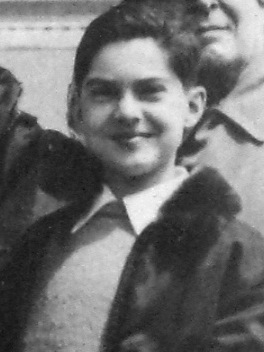
Arthur MacArthur IV is an American concert pianist, writer, and the only child of General Douglas MacArthur and Jean MacArthur. He is also the grandson of General Arthur MacArthur Jr.



















